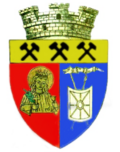Petrila
|
Petrila Petrilla |
||||
|
||||
| Basic data | ||||
|---|---|---|---|---|
| State : |
|
|||
| Historical region : | Transylvania | |||
| Circle : | Hunedoara | |||
| Coordinates : | 45 ° 27 ' N , 23 ° 24' E | |||
| Time zone : | EET ( UTC +2) | |||
| Height : | 675 m | |||
| Area : | 310.30 km² | |||
| Residents : | 22,692 (October 20, 2011) | |||
| Population density : | 73 inhabitants per km² | |||
| Postal code : | 335800 | |||
| Telephone code : | (+40) 02 54 | |||
| License plate : | HD | |||
| Structure and administration (as of 2016) | ||||
| Community type : | city | |||
| Structure : | Petrila, Cimpa , Jieț , Răscoala , Tirici | |||
| Mayor : | Vasile Jurca ( PSD ) | |||
| Postal address : | St. Republicii, no. 196 loc. Petrila, jud. Hunedoara, RO-335800 |
|||
| Website : | ||||
Petrila ( Hungarian Petrilla ) is a small town in the Hunedoara district in the Transylvania region in Romania .
Geographical location
Petrila lies on the river Jiul de Est ( German Eastern Schil ), between the mountains Șureanu in the north and Parâng in the south. The small town is located on the county road (drum județean) DJ 709K, about four kilometers east of the European route 79 and from Petroșani . The district capital Deva (Diemrich) is about 90 kilometers northwest of Petrila.
history
For a long time, the region of Petrila was sparsely populated, mainly by cattle herders. The village was first mentioned in a document at the end of the 15th century.
Petrila experienced a significant upswing after significant hard coal deposits were discovered in the 18th century and a mine went into operation in Petrila in 1859. Mining was the city's main industry from the last third of the 19th century and throughout the 20th century. At times 5,000 miners worked in the Petrila mine. The highest annual production was achieved in 1983 with 1.2 million tons of hard coal.
When the Romanian state began to reduce its mining subsidies with the gradual transition to a market economy after 1990, production in Petrila also sank drastically; In 2014 it was 110,000 tons. On November 15, 2008, there were two explosions in the Petrila mine, causing a total of 13 deaths. The Petrila mine was shut down at the end of October 2015. At last around 300 miners were employed there.
population
In 1850 Petrila, which at that time still belonged to the Kingdom of Hungary , had 2075 inhabitants, of whom 2016 were Romanians and 59 Gypsies . In 1920 the population had risen to around 10,600, of which 5500 identified themselves as Romanians, 3300 as Hungarians and 800 as Germans. The population continued to grow by 1992 (29,000). Since then the population has been falling slowly. At the 2002 census, 25,840 people lived in Petrila, of which 23,668 Romanians, 1509 Hungarians, 153 Roma and 73 Germans.
traffic
Petrila does not have a rail connection for passenger traffic. A narrow-gauge railway with the rare gauge of 790 mm leads from nearby Petroșani into the city, which is used for freight transport (mainly coal). Buses run several times a day to Petroșani.
sons and daughters of the town
- Ferenc Doór (1918–2015), Hungarian painter and graphic artist
Attractions
Petrila is a possible starting point for excursions into the surrounding mountains; The Taia and Jieț gorges are worth mentioning. The city itself is industrial and has no major tourist attractions.
Web links
Individual evidence
- ↑ 2011 census in Romania at citypopulation.de
- ↑ a b Out of Romania's oldest mine. Coal mine closes after 156 years . In: Frankfurter Allgemeine Zeitung, November 2, 2015, p. 27.
- ^ Spiegel Online, accessed November 22, 2008
- ^ Censuses in Transylvania 1850–2002 (Hungarian).
- ↑ The narrow-gauge railway between Petrila and the Lonea mine , pictures and brief information on the railway line in the Railnet.ro forum, accessed on January 12, 2014 (Romanian).

